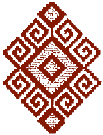 |
| Temple of the Columns platform at Chichen Itza |
The Maya are one of the best-known of the classical civilizations of Mesoamerica. Originating in the Yucatan around 2600 B.C., they rose to prominence around A.D. 250 in present-day southern Mexico, Guatemala, western Honduras, El Salvador, and northern Belize.
The Maya created a complex society that included literature, art, mathematics, astronomy, and calendrics. The Mayans are regarded as the inventors of many aspects of Mesoamerican cultures including the first calendar and hieroglyphic writing in the Western hemisphere. They built elaborate, highly decorated ceremonial temple-pyramids, palaces and observatories, all without metal tools. They were also skilled farmers who cleared large sections of rain forest and, where groundwater was scarce, built sizable underground reservoirs for the storage of rainwater. The Mayans were equally skilled as weavers and potters, and cleared routes through jungles and swamps to foster extensive trade networks with distant peoples.
The Maya are believed to have first settled Cozumel around 300 AD and during the height of the Mayan empire the island became an important port for trade because of its strategic location between Honduras and Vera Cruz. Salt and honey were trade products of the time produced on the island and brought to the mainland at Tulum.
The first Spanish visitor to Cozumel was Juan de Grijalva in 1518. The following year Hernán Cortés came to the island with a fleet and destroyed most Maya temples as they claimed Cozumel for Spain. Cortés proceeded to convert the natives and replaced their sacred Maya figures with a cross and statue of Mary in their main temple.
 |
Diamonds represent the Universe and the path of the sun in it's daily movement. |
 |
The Earthlord, "saint" of the underworld. |
In 1847, after Mexico had achieved independence, civil war erupted on the peninsula between European settlers and the exploited descendants of the ancient Maya. Known as the Caste War, this conflict ended in defeat for the Maya and resulted in resettlement of Cozumel by refugees escaping the tumult. An interesting side fact, a plaque at the Museo Cozumel states that Abraham Lincoln, an American president, came close to purchasing the island of Cozumel as a place to send the freed slaves, but the continued war in the Yucatan caused him to change his mind.
 |
| Calendar stone from central Mexico. |
Over the next hundred years the little town of San Miguel developed into a small, relatively prosperous fishing village until the early 60's when it was discovered by explorer and documentary film maker Jacques Cousteau who put it on the map as one of the greatest diving destinations in the world.



No comments:
Post a Comment